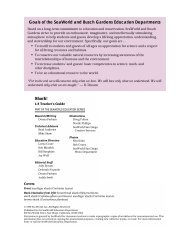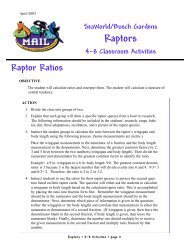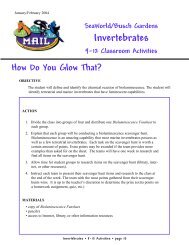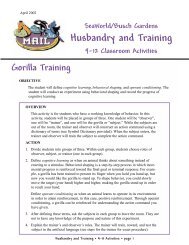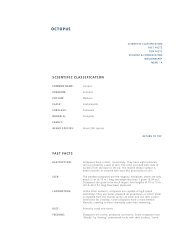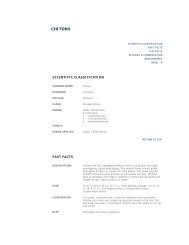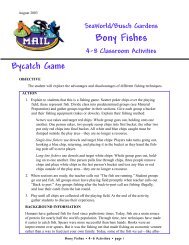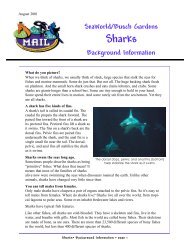Dihybrid crosses - Sea World
Dihybrid crosses - Sea World
Dihybrid crosses - Sea World
You also want an ePaper? Increase the reach of your titles
YUMPU automatically turns print PDFs into web optimized ePapers that Google loves.
March 2003<br />
<strong>Dihybrid</strong> Cross<br />
OBJECTIVE<br />
ACTION<br />
1. Divide the class into groups of four.<br />
<strong>Sea</strong><strong>World</strong>/Busch Gardens<br />
Genetics<br />
9-12 Classroom Activities<br />
The student will calculate a dihybrid cross and interpret the results.<br />
2. Distribute one Case Study Funsheet to each group. (Each group should have a<br />
different Case Study Funsheet to calculate).<br />
3. Instruct students to calculate a dihybrid cross based on the given information in the<br />
case study and answer the questions. Review how to calculate dihybrid <strong>crosses</strong> using<br />
the background information on page 2.<br />
4. Instruct students to present their calculations to the class.<br />
5. The answers may be checked with the Teacher’s Guide.<br />
MATERIALS<br />
• copy of each Case Study Funsheet<br />
• copy of Case Study Teacher Guide<br />
• pencils<br />
albinism: The inherited absence of pigment.<br />
allele: Alternative form of a gene.<br />
dihybrid Cross: A breeding experiment in<br />
which parental varieties differing in two<br />
traits are mated.<br />
dominant: An allele that determines phenotype<br />
even when heterozygous.<br />
gamete: Haploid egg or sperm cells that<br />
unite during sexual reproduction to produce<br />
a diploid zygote.<br />
genetics: The science of heredity; the study<br />
of heritable information.<br />
gene: One of many discrete units of hereditary<br />
information located on the chromo-<br />
VOCABULARY<br />
Genetics • 9-12 Activities • page 1<br />
somes and consisting of DNA.<br />
genotype: The genetic make-up of an<br />
organism.<br />
heterozygous: Having two different alleles<br />
for a given trait.<br />
homozygous: Having two identical alleles<br />
for a given trait.<br />
prehensile: Capable of grasping or holding.<br />
recessive: An allele that is not expressed in<br />
the heterozygous condition.<br />
spicule: A pointed modified scale that various<br />
raptors use to grip prey.<br />
tendon: A type of fibrous connective tissue<br />
that attaches muscle to bone.
HOW TO CALCULATE DIHYBRID CROSSES<br />
1. To set up a dihybrid cross, draw a large square, and then divide it into 16 equal squares.<br />
2. Determine the genotypes of the parent organisms. Sometimes the cross is already<br />
specified.For example: Cross two organisms with the following genotypes: PpTt & PpTt.<br />
However, many times genetic vocabulary must be understood to determine the genotypes<br />
of the cross. For example: Cross a short white flower with one that is heterozygous for purple<br />
flower color and homozygous for tallness. Purple is dominant and white is recessive<br />
and tall is dominant and short is recessive. Therefore, the only way to express a short white<br />
flower is to be homozygous recessive for both traits (color and height) and its genotype<br />
will be (pptt). Heterozygous always means one of each letter. Therefore a plant that is heterozygous<br />
for purple color would have the genotype Pp. A plant that is homozygous for<br />
tallness would have the genotype TT. Therefore, the flower will have a complete genotype<br />
of PpTT and the cross would be between pptt x PpTT.<br />
3. Determine the possible gametes of each parent. For example, if a parent has a genotype<br />
of PpTt, then the gametes will receive one of each pair (Pp and Tt) of alleles. There will be<br />
four possible combinations of alleles and each PT Pt pT pt<br />
have an equal probability of occurring. The<br />
four possible allele combinations from the<br />
parent PpTt are PT, Pt, pT, and pt.<br />
PT<br />
4. Place the four possible allele combination<br />
Pt<br />
for each parent outside the dihybrid cross<br />
square. One parent's allele combinations will<br />
be placed on top of the dihybrid cross square<br />
pT<br />
and the other will be split to the left of the<br />
dihybrid cross square.<br />
pt<br />
5. Determine the possible genotypes<br />
PT Pt pT pt<br />
of the offspring by filling in the<br />
dihybrid cross square. This step is accom-<br />
PT PPTT PPTt PpTT PpTt<br />
plished by taking a letter from the left and<br />
matching it with a letter from the top.<br />
Pt PPTt PPtt PpTt Pptt<br />
Repeat this step until all 16 boxes of the<br />
dihybrid cross square are complete. pT PpTT PpTt ppTT ppTt<br />
6. Summarize the genotypes and<br />
phenotypes of the offspring.<br />
PpTt PpTt ppTt pptt<br />
The possible genotypes from the parental cross of PpTt x PpTt are:<br />
PPTT PPTt PpTT PpTt PPtt Pptt ppTT ppTt pptt<br />
Tall (TT, Tt) purple (PP, Pp) flowers will be produced by the following genotypes<br />
PPTT (1/16) PPTt (2/16) PpTT (2/16) PpTt (4/16) the frequency is stated in ( )<br />
Therefore 9 out of 16 possibilities could be tall purple flowers.<br />
Tall (TT, Tt) white (pp) flowers will be produced by the following genotypes.<br />
ppTT (1/16) ppTt (2/16) Therefore 3 out of 16 possibilities could be tall white flowers.<br />
Short (tt) purple (PP, Pp) flowers will be produced by the following genotypes.<br />
PPtt (1/16) Pptt (2/16) Therefore 3 out of 16 possibilities could be short purple flowers.<br />
Short (tt) white (pp) flowers will be produced by the following genotypes.<br />
pptt (1/16) Therefore 1 out of 16 possibilities could be short white flowers.<br />
pt<br />
Genetics • 9-12 Activities • page 2 © 2003 Busch Gardens.
Black Rhino Case Study (Diceros bicornis)<br />
You are a wildlife biologist researching black rhinos. During your time in Africa, you have observed two particular<br />
traits that allow some black rhinos to be better adapted to their environment. The first trait is an extra long prehensile<br />
lip that enables the rhino to have more efficient browsing capability than the usual size prehensile lip. Second, some of<br />
the rhinos in the study have extra long ears that allow them to hear a potential predator earlier than rhinos with normal<br />
size ears. If you could breed black rhinos that have both these traits (extra long prehensile lip and bigger ears), it would<br />
increase their chance for survival in the wild.<br />
You have chosen the following two rhinos to enter into a breeding program for the two desired phenotypic traits. It has<br />
been determined (based on your previous research) that both the desired traits are homozygous recessive.<br />
Parent 1:<br />
Homozygous dominant for the prehensile lip trait (PP). Therefore this parent does not express the<br />
extra long lip trait.<br />
Heterozygous for the longer ear trait (Ee). Therefore this parent does not express the extra large ear<br />
trait.<br />
Parent 2:<br />
Heterozygous for the prehensile lip trait (Pp). Therefore this parent does not express the extra long<br />
lip trait.<br />
Homozygous recessive for the large eared trait (ee). Therefore the parent does express the extra<br />
long ear trait.<br />
Parent 2<br />
Genotype<br />
Possible<br />
Alleles<br />
Parent 1 Genotype<br />
Questions:<br />
1. Determine the possible genotype (s) that will produce individuals without an extra long lip trait<br />
and do not express the extra large ear trait. What is the frequency that each of these genotype<br />
(s) occur in the dihybrid cross?<br />
2. Determine the possible genotype (s) that will produce individuals that have a normal lip and the<br />
extra large ears? What is the frequency that each of these genotype (s) occur in the dihybrid<br />
cross?<br />
3. How many rhinos can be produced with the extra long lip and large ear trait from the two parents<br />
crossed above? Explain your answer.<br />
4. What is the ratio between rhinos that have normal prehensile lips and ears to those that have the<br />
normal lip but extra large ears? (Normal lip and ears: Normal lip and extra large ears).<br />
Genetics • 9-12 Activities • page 3 © 2003 Busch Gardens.
Burmese Python (Python molurus bivittatus)<br />
You are a wildlife biologist researching Burmese pythons. During your time in Asia, you observed a particular trait that<br />
allows some Burmese pythons to be better adapted to their environment. Some snakes have extra large scales on their<br />
abdomen. This increases the surface area of their abdomen that is in contact with the ground, therefore, making locomotion<br />
easier. In addition, you noticed that albino Burmese pythons do not survive as long in the wild as those who<br />
have normal pigmentation because lack of camouflage ability (beige blotches on a dark brown background). If you<br />
could breed Burmese pythons that have normal pigmentation (avoiding albinism) and extra large<br />
abdominal scales, it would increase their chance for survival in the wild.<br />
You have chosen the following two Burmese pythons to enter into a breeding program for the two desired phenotypic<br />
traits. It has been determined that the trait for the extra large abdominal scales is homozygous recessive. Albinism is<br />
also a homozygous recessive trait. The normal pigmentation trait is dominant and is expressed in homozygous dominant<br />
and heterozygous individuals.<br />
Parent 1:<br />
Heterozygous for the extra large ventral (abdomen) scales (Ss). Therefore this parent does not<br />
express the extra large scale trait.<br />
Heterozygous for the pigmentation trait (Pp). Therefore this parent expresses the normal pigmentation.<br />
Parent 2:<br />
Heterozygous for the extra large ventral (abdomen) scales (Ss). Therefore this parent does not<br />
express the extra large scale trait.<br />
Heterozygous for the pigmentation trait (Pp). Therefore this parent expresses the normal pigmentation.<br />
Parent 2<br />
Genotype<br />
Possible<br />
Alleles<br />
Parent 1 Genotype<br />
Questions:<br />
1. Determine the possible genotype (s) that will produce individuals that have normal sized scales<br />
(do not express the extra large abdominal scales) and have normal pigmentation (do not express<br />
albinism). What is the frequency that each of these genotype (s) occur in the dihybrid cross?<br />
2. Determine the possible genotype (s) that will produce individuals that have normal scales and are<br />
albino? What is the frequency that each of these genotype(s) occur in the dihybrid cross?<br />
3. Determine the possible genotype (s) that will produce individuals with extra large abdominal<br />
scales and have normal pigmentation. What is the frequency that each of these genotype (s)<br />
occur in the dihybrid cross?<br />
4. Determine the possible genotypes that produce individuals with extra large scales and are albino?<br />
Which of these genotypes occur in the dihybrid cross?<br />
5. What is the ratio between the four phenotypic traits (normal scales with normal pigment,<br />
albinism with normal scales, extra large scales with normal pigment, and albinism with extra<br />
large scales).<br />
Genetics • 9-12 Activities • page 4 © 2003 Busch Gardens.
Prehensile-tailed Porcupine (Coendou prehensilis)<br />
You are a wildlife biologist researching prehensile-tailed porcupines. During your time in South America, you have<br />
observed two particular traits that allow some porcupines to be better adapted to their environment. The first trait is an<br />
extra long prehensile tail that enables the porcupine to have more efficient grasping capabilities than the usual length prehensile<br />
tail. Second, some of the porcupines in the study have extra long whiskers on their face and feet that allow them<br />
to sense their environment better than those that have normal size whiskers. If you could breed prehensile-tailed porcupines<br />
that have both these traits (extra long prehensile tail and whiskers), it would increase their chance for survival in<br />
the wild. You have chosen the following two porcupines to enter into a breeding program for the two desired phenotypic<br />
traits. It has been determined (based on your previous research) that both the desired traits are homozygous recessive.<br />
Parent 1:<br />
Heterozygous for the extra long prehensile tail trait (Tt). Therefore this parent does not express the<br />
extra long tail trait.<br />
Heterozygous for the extra long whisker trait (Ww). Therefore this parent does not express the extra<br />
long whisker trait.<br />
Parent 2:<br />
Heterozygous for the extra long prehensile tail trait (Tt). Therefore this parent does not express the<br />
extra long tail trait.<br />
Heterozygous for the extra long whisker trait (Ww). Therefore this parent does not express the extra<br />
long whisker trait.<br />
Parent 2<br />
Genotype<br />
Possible<br />
Alleles<br />
Parent 1 Genotype<br />
Questions:<br />
1. Determine the possible genotype(s) that will produce individuals that have normal sized prehensile<br />
tails (do not express the extra long prehensile tail) and have normal sized whiskers (do not<br />
express the extra long whisker trait). What is the frequency that each of these genotype (s)<br />
occur in the dihybrid cross?<br />
2. Determine the possible genotype(s) that will produce individuals that have normal sized prehensile<br />
tails and extra long whiskers? What is the frequency that each of these genotype (s) occur<br />
in the dihybrid cross?<br />
3. Determine the possible genotype(s) that will produce individuals with extra long prehensile tails<br />
and have normal whiskers. What is the frequency that each of these genotype (s) occur in the<br />
dihybrid cross?<br />
4. Determine the possible genotype(s) that produce individuals with extra long prehensile tails and<br />
whiskers. What is the frequency that each of these genotype(s) occur in the dihybrid cross?<br />
5. What is the ratio between the four phenotypic traits (normal tails with normal whiskers, normal<br />
tails with extra long whiskers, extra long tail with normal whiskers, and extra long tails with<br />
extra long whiskers)?<br />
Genetics • 9-12 Activities • page 5 © 2003 Busch Gardens.
Leaf-Nosed Bat (Carollia perspicillata)<br />
You are a wildlife biologist researching leaf-nosed bats. During your time in South America, you have observed two particular<br />
traits that allow some leaf-nosed bats to be better adapted to their environment. The first trait is an extra large leaf<br />
nose that enables the bat to echolocate and find food more effectively than the usual size leaf nose. Second, some of the<br />
bats in the study have stronger tendons in their feet than others. The bats that have stronger tendons are able to hang<br />
upside from branches longer than those who do not have as strong of tendons. If you could breed leaf-nosed bats that<br />
have both these traits (stronger tendons and larger leaf nose), it would increase their chance for survival in the wild.<br />
You have chosen the following two bats to enter into a breeding program for the two desired phenotypic traits. It has<br />
been determined (based on your previous research) that both the desired traits are homozygous recessive.<br />
Parent 1:<br />
Heterozygous dominant for the leaf-nose trait (Nn). Therefore this parent does not express the extra<br />
large leaf-nose trait.<br />
Homozygous recessive for the extra strong tendon trait (tt). Therefore this parent does express the<br />
extra strong tendon trait.<br />
Parent 2:<br />
Homozygous recessive for the leaf-nose trait (nn). Therefore this parent does express the extra large<br />
leaf-nose trait.<br />
Homozygous recessive for the extra strong tendon trait (tt). Therefore the parent does express the<br />
extra strong tendon trait.<br />
Questions:<br />
Parent 2<br />
Genotype<br />
Possible<br />
Alleles<br />
Parent 1 Genotype<br />
1. Determine the possible genotype(s) that will produce individuals that have a normal size leafnose<br />
(do not express the extra large leaf-nose trait) and have normal claw curvature (do not<br />
express the extra claw curvature trait). What is the frequency that each of these genotype (s)<br />
occur in the dihybrid cross?<br />
2. Determine the possible genotype (s) that will produce individuals that have a normal size leafnose<br />
and the extra claw curvature? What is the frequency that each of these genotype (s) occur<br />
in the dihybrid cross?<br />
3. Determine the possible genotype(s) that will produce individuals that have the extra large leafnose<br />
and extra claw curvature. What is the frequency that each of these genotype (s) occur in<br />
the dihybrid cross?<br />
4. What is the ratio between rhinos that have normal a leaf-nose and extra claw curvature to those<br />
that have extra claw curvature and larger leaf-nose? (Normal leaf-nose and extra claw curvature<br />
to larger leaf-nose and extra claw curvature).<br />
Genetics • 9-12 Activities • page 6 © 2003 Busch Gardens.
Osprey (Pandion haliaetus)<br />
You are a wildlife biologist researching ospreys. During your time in North America, you have observed two particular<br />
traits that allow some ospreys to be better adapted to their environment. The first trait is extra pigmentation in the dark<br />
band that extends from the beak through the eye. The extra dark band enables the osprey to reduce glare from the sun<br />
more than ospreys that do not have the extra dark pigmentation. Second, some of the ospreys in the study have extra<br />
long spicules than others. The ospreys that have these extra long spicules are able to capture prey more efficiently than<br />
those who do not have the extra long spicules. If you could breed ospreys that have both these traits (extra pigmentation<br />
and longer spicules), it would increase their chance for survival in the wild.<br />
You have chosen the following two ospreys to enter into a breeding program for the two desired phenotypic traits. It has<br />
been determined (based on your previous research) that both the desired traits are homozygous recessive.<br />
Parent 1:<br />
Heterozygous dominant for the extra pigmentation trait (Pp). Therefore this parent does not express<br />
the extra pigmentation trait.<br />
Homozygous recessive for the extra long spicule trait (ss). Therefore this parent does express the<br />
extra long spicule trait.<br />
Parent 2:<br />
Homozygous recessive for the extra pigmentation trait (pp). Therefore this parent does express the<br />
extra pigmentation trait.<br />
Heterozygous dominant for the extra long spicule trait (Ss). Therefore the parent does not express<br />
the extra long spicule trait.<br />
Parent 2<br />
Genotype<br />
Possible<br />
Alleles<br />
Parent 1 Genotype<br />
Questions:<br />
1. Determine the possible genotype (s) that will produce individuals that have normal pigment (do not<br />
express the extra dark pigment in the band that extends from the beak through the eye) and have normal<br />
length spicules (do not express the extra long spicule trait). What is the frequency that each of these<br />
genotype (s) occur in the dihybrid cross?<br />
2. Determine the possible genotype (s) that will produce individuals that have normal pigment and extra long<br />
spicules? What is the frequency that each of these genotype (s) occur in the dihybrid cross?<br />
3. Determine the possible genotype (s) that will produce individuals with extra dark pigment in their eye<br />
band and have normal spicules. What is the frequency that each of these genotype (s) occur in the dihybrid<br />
cross?<br />
4. Determine the possible genotype (s) that produce individuals with extra pigment in the eye band and extra<br />
long spicules. What is the frequency that each of these genotype(s) occur in the dihybrid cross?<br />
5. What is the ratio between the four phenotypic traits (normal pigment with normal spicules, extra pigment<br />
with normal spicules, normal pigment with extra long spicules, and extra pigment with extra long<br />
spicules)?<br />
Genetics • 9-12 Activities • page 7 © 2003 Busch Gardens.
Bongo Antelope (Tragelaphus eurycerus )<br />
You are a wildlife biologist researching bongo antelope. During your time in Africa, you have observed two particular<br />
traits that allow some bongos to be better adapted to their environment. The first trait is that some bongos have thicker<br />
horns than others. The thick horns enable the bongo to defend itself better than bongos that do not have the thicker<br />
horns. Second, some of the bongos in the study have longer prehensile tongues than others. The bongos that have this<br />
extra long prehensile tongue are able to browse for food more efficiently than those who do not have this trait. If you<br />
could breed bongos that have both these traits (thicker horns and longer prehensile tongues), it would increase their<br />
chance for survival in the wild.<br />
You have chosen the following two bongos to enter into a breeding program for the two desired phenotypic traits. It has<br />
been determined (based on your previous research) that both the desired traits are homozygous recessive.<br />
Parent 1:<br />
Heterozygous dominant for the horn trait (Hh). Therefore this parent does not express the extra<br />
thick horn trait.<br />
Heterozygous dominant for the prehensile tongue trait (Ll). Therefore this parent does not express<br />
the extra long prehensile lip trait.<br />
Parent 2:<br />
Heterozygous dominant for the horn trait (Hh). Therefore this parent does not express the extra<br />
thick horn trait.<br />
Heterozygous dominant for the prehensile tongue trait (Ll). Therefore the parent does not express<br />
the extra long prehensile tongue trait.<br />
Questions:<br />
Parent 2<br />
Genotype<br />
Possible<br />
Alleles<br />
Parent 1 Genotype<br />
1. Determine the possible genotype (s) that will produce individuals that have normal horns (do not express<br />
the extra thick horns) and have a normal prehensile tongue (do not express the extra long prehensile<br />
tongue trait). What is the frequency that each of these genotype (s) occur in the dihybrid cross?<br />
2. Determine the possible genotype (s) that will produce individuals that have normal horns and the extra<br />
long prehensile tongue trait? What is the frequency that each of these genotype (s) occur in the dihybrid<br />
cross?<br />
3. Determine the possible genotype (s) that will produce individuals with extra thick horns and have a normal<br />
prehensile tongue. What is the frequency that each of these genotype (s) occur in the dihybrid cross?<br />
4. Determine the possible genotype (s) that produce individuals with extra thick horns and extra long prehensile<br />
tongue. What is the frequency that each of these genotype(s) occur in the dihybrid cross?<br />
5. What is the ratio between the four phenotypic traits (normal horns with normal prehensile tongue, normal<br />
horns with extra long prehensile tongue, thick horns with normal prehensile tongues, and extra thick<br />
horns with extra long prehensile tongues)?<br />
Genetics • 9-12 Activities • page 8 © 2003 Busch Gardens.
BLACK RHINO<br />
Parent 2<br />
Genotype<br />
Pp ee<br />
Possible<br />
Alleles<br />
Pe<br />
Pe<br />
Pe<br />
Pe<br />
TEACHER’S GUIDE ANSWERS<br />
1. Determine the possible genotype (s) that will produce individuals that have a normal prehensile<br />
lip (do not express the extra long lip trait) and have normal ears (do not express the extra long<br />
ear trait). What is the frequency that each of these genotype (s) occur in the dihybrid cross?<br />
PPEe (4/16) PpEe (4/16)<br />
2. Determine the possible genotype (s) that will produce individuals that have a normal lip and the<br />
extra long ears? What is the frequency that each of these genotype (s) occur in the dihybrid<br />
cross?<br />
Ppee (4/16) Ppee (4/16)<br />
Parent 1 Genotype<br />
PP Ee<br />
PE Pe PE Pe<br />
PPEe PPee PPEe PPee<br />
PPEe PPee PPEe PPee<br />
PpEe Ppee PpEe Ppee<br />
PpEe Ppee PpEe Ppee<br />
3. How many rhinos will have the extra long lip and ear trait from the two parents crossed above?<br />
Explain your answer.<br />
None, because one of the parents is homozygous dominant for the normal prehensile lip trait.<br />
Therefore, that parent will contribute one dominant allele for the normal prehensile lip trait to<br />
all offspring possibilities. The recessive trait of having an extra long prehensile lip can only be<br />
expressed if a recessive allele is contributed by each parent.<br />
4. What is the ratio between rhinos that have normal prehensile lips and ears to those that have the<br />
normal lip but extra long ears? (Normal lip and ears : Normal lip and extra long ears).<br />
8:8 or 1 to 1. There is an equal probability of having normal prehensile lip individuals with normal<br />
ears as there is a chance of having normal prehensile lip individuals with extra long ears.<br />
Genetics • 9-12 Activities • page 9 © 2003 Busch Gardens.
BURMESE PHYTHON<br />
TEACHER’S GUIDE ANSWERS<br />
1. Determine the possible genotype (s) that will produce individuals that have normal sized scales<br />
(do not express the extra large abdominal scales) and have normal pigmentation (do not express<br />
albinism). What is the frequency that each of these genotype (s) occur in the dihybrid cross?<br />
SSPP (1/16) SSPp (2/16) SsPP (2/16) SsPp (4/16)<br />
2. Determine the possible genotype (s) that will produce individuals that have normal scales and are<br />
albino? What is the frequency that each of these genotype(s) occur in the dihybrid cross?<br />
SSpp (1/16) Sspp (2/16)<br />
3. Determine the possible genotype (s) that will produce individuals with extra large abdominal<br />
scales and have normal pigmentation. What is the frequency that each of these genotype (s)<br />
occur in the dihybrid cross?<br />
ssPP (1/16) ssPp (2/16)<br />
4. Determine the possible genotype (s) that produce individuals with extra large scales and are albino?<br />
What is the frequency that each of these genotype (s) occur in the dihybrid cross?<br />
sspp (1/16)<br />
5. What is the ratio between the four phenotypic traits (normal scales with normal pigment,<br />
albinism with normal scales, extra large scales with normal pigment, and albinism with extra<br />
large scales).<br />
9:3:3:1<br />
Parent 2<br />
Genotype<br />
SS Pp<br />
Possible<br />
Alleles<br />
SP<br />
SP<br />
SP<br />
Sp<br />
Parent 1 Genotype<br />
SsPp<br />
SP Sp sP sp<br />
SSPP SSPp SsPP SsPp<br />
SSPp SSpp SpSp Sspp<br />
SsPP SsPp ssPP ssPp<br />
SsPp Sspp ssPp sspp<br />
Genetics • 9-12 Activities • page 10 © 2003 Busch Gardens.
PREHENSILE-TAILED PORCUPINE<br />
Questions:<br />
Parent 2<br />
Genotype<br />
Tt Ww<br />
Possible<br />
Alleles<br />
TW<br />
Tw<br />
tW<br />
tw<br />
TEACHER’S GUIDE ANSWERS<br />
Parent 1 Genotype<br />
Tt Ww<br />
TW Tw tW Tw<br />
TTWW TTWw TtWW TtWw<br />
TTWw TTww TtWw Ttww<br />
TtWW TtWw ttWW TtWw<br />
TtWw Ttww ttWw Ttww<br />
1. Determine the possible genotype (s) that will produce individuals that have normal sized prehensile<br />
tails (do not express the extra long prehensile tail) and have normal sized whiskers (do<br />
not express the extra long whisker trait). What is the frequency that each of these genotype (s)<br />
occur in the dihybrid cross?<br />
TTWW (1/16) TTWw (2/16)<br />
TtWW (2/16) TtWw (4/16)<br />
2. Determine the possible genotype (s) that will produce individuals that have normal sized prehensile<br />
tails and extra long whiskers? What is the frequency that each of these genotype (s)<br />
occur in the dihybrid cross?<br />
TTww (1/16) Ttww (2/16)<br />
3. Determine the possible genotype (s) that will produce individuals with extra long prehensile<br />
tails and have normal whiskers. What is the frequency that each of these genotype (s) occur in<br />
the dihybrid cross?<br />
ttWW (1/16) ttWw (2/16)<br />
4. Determine the possible genotype (s) that produce individuals with extra long prehensile tails and<br />
whiskers. What is the frequency that each of these genotype(s) occur in the dihybrid cross?<br />
ttww (1/16)<br />
5. What is the ratio between the four phenotypic traits (normal tails with normal whiskers, normal<br />
tails with extra long whiskers, extra long tail with normal whiskers, and extra long tails with<br />
extra long whiskers)?<br />
9:3:3:1<br />
Genetics • 9-12 Activities • page 11 © 2003 Busch Gardens.
LEAF-NOSED BAT<br />
Questions:<br />
Parent 2<br />
Genotype<br />
nn tt<br />
TEACHER’S GUIDE ANSWERS<br />
1. Determine the possible genotype (s) that will produce individuals that have a normal size leafnose<br />
(do not express the extra large leaf-nose trait) and have normal tendon strength (do not<br />
express the extra strong tendon trait). What is the frequency that each of these genotype (s)<br />
occur in the dihybrid cross?<br />
None, because both parents are homozygous recessive for the extra claw curvature. Every offspring<br />
they produce will have this trait.<br />
2. Determine the possible genotype (s) that will produce individuals that have a normal size leafnose<br />
and the extra strong tendons? What is the frequency that each of these genotype (s) occur<br />
in the dihybrid cross?<br />
Nntt (8/16)<br />
3. Determine the possible genotype (s) that will produce individuals that have the extra large leafnose<br />
and extra strong tendons. What is the frequency that each of these genotype (s) occur in<br />
the dihybrid cross?<br />
nntt (8/16)<br />
4. What is the ratio between bats that have a normal leaf-nose and extra strong tendons to those<br />
that have extra strong tendons and larger leaf-nose? (Normal leaf-nose and extra strong tendons<br />
to larger leaf-nose and extra strong tendons).<br />
8:8 or 1:1<br />
Possible<br />
Alleles<br />
nt<br />
nt<br />
nt<br />
nt<br />
Parent 1 Genotype<br />
Nn tt<br />
Nt Nt nt nt<br />
Nntt Nntt nntt nntt<br />
NnTT Nntt nntt nntt<br />
Nntt Nntt nntt nntt<br />
Nntt Nntt nntt nntt<br />
Genetics • 9-12 Activities • page 12 © 2003 Busch Gardens.
OSPREY<br />
Questions:<br />
Parent 2<br />
Genotype<br />
pp Ss<br />
Possible<br />
Alleles<br />
TEACHER’S GUIDE ANSWERS<br />
1. Determine the possible genotype (s) that will produce individuals that have normal pigment (do<br />
not express the extra dark pigment in the band that extends from the beak through the eye) and<br />
have normal length spicules (do not express the extra long spicule trait). What is the frequency<br />
that each of these genotype (s) occur in the dihybrid cross?<br />
PpSs (4/16)<br />
2. Determine the possible genotype (s) that will produce individuals that have normal pigment and<br />
extra long spicules? What is the frequency that each of these genotype (s) occur in the dihybrid<br />
cross?<br />
Ppss (4/16)<br />
3. Determine the possible genotype (s) that will produce individuals with extra dark pigment in<br />
their eye band and have normal spicules. What is the frequency that each of these genotype (s)<br />
occur in the dihybrid cross?<br />
PpSs (4/16)<br />
4. Determine the possible genotype (s) that produce individuals with extra pigment in the eye band<br />
and extra long spicules. What is the frequency that each of these genotype(s) occur in the dihybrid<br />
cross?<br />
ppss (4/16)<br />
5. What is the ratio between the four phenotypic traits (normal pigment with normal spicules, extra<br />
pigment with normal spicules, normal pigment with extra long spicules, and extra pigment with<br />
extra long spicules)?<br />
4:4:4:4 or 1:1:1:1<br />
pS<br />
ps<br />
pS<br />
ps<br />
Parent 1 Genotype<br />
Pp ss<br />
Ps Ps ps ps<br />
PpSs PpSs ppSs ppSs<br />
Ppss Ppss ppss ppss<br />
PpSs PpSs ppSs ppSs<br />
Ppss Ppss ppss ppss<br />
Genetics 9-12 Activities • page 13 © 2003 Busch Gardens.
BONGO ANTELOPE<br />
TEACHER’S GUIDE ANSWERS<br />
1. Determine the possible genotype (s) that will produce individuals that have normal horns (do<br />
not express the extra thick horns) and have a normal prehensile tongue (do not express the extra<br />
long prehensile tongue trait). What is the frequency that each of these genotype (s) occur in the<br />
dihybrid cross?<br />
HHLL (1/16) HHLl (2/16) HhLL (2/16) HhLl (4/16)<br />
2. Determine the possible genotype (s) that will produce individuals that have normal horns and<br />
the extra long prehensile tongue trait? What is the frequency that each of these genotype (s)<br />
occur in the dihybrid cross?<br />
HHll (1/16) Hhll (2/16)<br />
3. Determine the possible genotype (s) that will produce individuals with extra thick horns and<br />
have a normal prehensile tongue. What is the frequency that each of these genotype (s) occur in<br />
the dihybrid cross?<br />
hhLL (1/16) hhLl (2/16)<br />
4. Determine the possible genotype (s) that produce individuals with extra thick horns and extra<br />
long prehensile tongue. What is the frequency that each of these genotype(s) occur in the dihybrid<br />
cross?<br />
hhll (1/16)<br />
5. What is the ratio between the four phenotypic traits (normal horns with normal prehensile<br />
tongue, normal horns with extra long prehensile tongue, thick horns with normal prehensile<br />
tongues, and extra thick horns with extra long prehensile tongues)?<br />
9:3:3:1<br />
Parent 2<br />
Genotype<br />
Hh Ll<br />
Possible<br />
Alleles<br />
HL<br />
Hl<br />
hL<br />
hl<br />
Parent 1 Genotype<br />
Hh Ll<br />
HL Hl hL hl<br />
HHLL HHLl HhLL HhLl<br />
HHLl HHll HhLl Hhll<br />
HhLL HhLl hhLL hhLl<br />
HhLl Hhll hhLl hhll<br />
Genetics • 9-12 Activities • page 14 © 2003 Busch Gardens.






